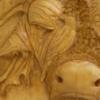
Demo: different coloring techniques
By
ClayB, in Dyes, Antiques, Stains, Glues, Waxes, Finishes and Conditioners.

By
ClayB, in Dyes, Antiques, Stains, Glues, Waxes, Finishes and Conditioners.